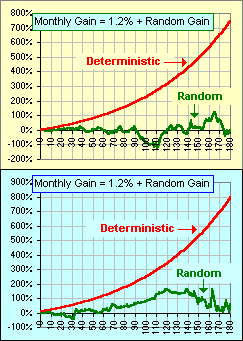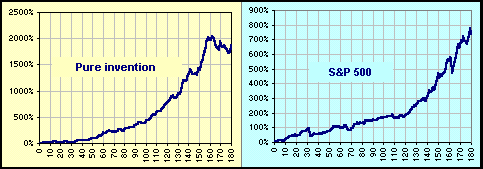|
Markets are Random ... or are they? |
Once upon a time I ran across a discussion of Randomness in the stock market. I got to
thinking ...
>Good for you!
... that, although the future evolution of the market (or a particular stock)
isn't predictable with any degree of accuracy, one doesn't expect every future is
equally likely ... some futures are more likely than others.
>Like the weather, eh? Snow in July? Unlikely.
Exactly! Yet a weather prediction which is off by a few degrees is quite likely.
>In Dallas, it's likely to be off by 10 degrees and ...
Anyway, I suspect it's reasonable to consider that markets have a certain degree of uncertainty which may be large ... or small. Just like the weather. A forecast which gives tomorrow's time of sunrise, say 5:24 A.M., has little uncertainty. A forecast which says that tomorrow's DOW will increase by 200 points has a much larger uncertainty. Suppose we consider a stock which grows, monthly at a fixed, deterministic rate of 1.2% plus a random, hence unpredictable, rate. Is the future evolution random?
|
>Not entirely, I'd say ... it does have a random component.
The chart at the right shows two possible 15-year evolutions. Although we can't be sure of the
random component, we'd like to feel that there's a more predictable component involved.
Well, the first is, but the second is .... uh ... the last fifteen years of the S&P 500.
|

|
>Are you saying that the S&P 500 has a predictable component?
Of course not. I'm saying that there's a degree of uncertainty associated with the S&P 500. In fact, the past fifteen years can be generated as a combination of a deterministic component plus a random component. However ...
>What about the next 15 years?
Good question. However, I can promise you that, whatever it is, it can be generated as a combination of a deterministic component plus a random component.
>And can you tell me what the deterministic component is, for the next fifteen years?
No, but ...
>Then you might as well consider it entirely unpredictable!
No, I don't think so. It just has a certain degree of uncertainty. Have you ever heard of Heisenberg's Uncertainty Principle?
>No, but ...
I think that even if we could compute the deterministic component with greater and greater precision, the random component becomes more and more uncertain. That should not deter us from trying to estimate the deterministic component. For example, if we knew the past history of a comet, Sir Isaac Newton would have said that the entire future path of the comet is deterministic. Heisenberg would disagree. There's always uncertainty.
>Mumbo jumbo.
Let's do a wee bit of math.
>I can see more mumbo jumbo coming.
Suppose that a stock grows with a monthly (or daily or annual or whatever) rate of R. (For a 1.2% rate, we'd put R = 0.012.)
In addition, there's a random component, say x.
We start with a portfolio of $P(0), then:
After one month our portflio grows to
P(1) = P(0)(1+R+x1).
After two months, it's grown to P(2) = P(0)(1+R+x1)(1+R+x2).
After N months, it's grown to P(N) = P(0)
(1+R+x1)(1+R+x2)...
(1+R+xN).
>I assume that the xs are a random set of numbers.
Right.
Okay, we rewrite the N-month portfolio as:
P(N) = P(0) (1+R)N {1+x1/(1+R)} {1+x2/(1+R)} ... {1+xN/(1+R)}We now choose R as the annualized gain, so P(N) = (1+R)N P(0) so we now have:
{1+x1/(1+R)} {1+x2/(1+R)} ... {1+xN/(1+R)} = 1
For sanitary reasons, we'll assume that the set of random numbers xn have some statistical distribution (like Normal of Log-normal or whatever) with Mean = m and Standard Deviation = s. Then, if we multiply the factors above and identify the first few terms, we get:
1 + { x1+x2+...+xN }/(1+R) + { x1x2+x1x3+... +xN-1xN }/(1+R)2 + ... = 1But { x1+x2+...+xN }/N = m, the mean of the xs, and we can cancel the "1" on each side, so we now have:
mN/(1+R) + { x1x2+x1x3+... +xN-1xN }/(1+R)2 + ... = 0or, more simply,
mN + { x1x2+x1x3+... +xN-1xN }/(1+R) + ... = 0
>I knew it'd be mumbo jumbo!
Okay, we'll now put xn = m + syn where the set
yn is a set with Mean = 0 and Standard Deviation (SD) = 1.
>What!?
Just read SD stuff where we note that:
"... if we have a collection of numbers, say {Gk}, with Mean = 0 and SD = 1, then the collection {λ Gk + C} will have Mean = C and Standard Deviation = λ."
Okay, let's forge ahead.


